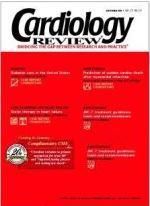Publication
Article
Cardiology Review® Online
Variation of fibrinogen in hypertensive patients
We understand a great deal about the etiology of cardiovascular disease; however, the triggers that lead to acute events often remain elusive. Why does a plaque rupture or a ventricular arrhythmia occur today and not a few months from now, or why at this moment and not 6 hours from now? The timing of events appears to follow both a circadian (daily) and circannual (seasonal) pattern. In the early waking hours, there is an increase in catecholamines, which is associated with a variety of other neurohormonal changes. This is one of the potential explanations for an increase in the incidence of events in the early waking hours.
Another source of variation is related to the seasons. More events occur in the winter than in the summer months.1 The explanation for this observation is not clear, but it might be related to changes in the duration of daylight hours, temperature variation, activity levels, or the emotional state related to holidays.2 An animal model of sudden death and inducible ventricular arrhythmias in dogs, however, suggests a seasonal variation that is not related to these factors.3
Blood pressure changes throughout a 24-hour period have been well characterized. During sleep, the normal pattern includes a decrease in blood pressure, which is called “dipping.” Many studies have demonstrated that “nondippers” are at increased risk for cardiovascular disease. Thus, lack of the “normal” circadian variation in this instance leads to a greater 24-hour load on the heart.
In this issue, Hermida and colleagues (page 38) describe interesting results related to both circadian and circannual variation from an observational study of over 1,000 patients with hypertension. Patients were characterized as nondippers or dippers using ambulatory blood pressure monitoring. Nondippers were found to have higher fibrinogen levels than dippers. Furthermore, fi-brinogen levels were higher in the winter months, peaking in February, than in the summer months, in both dippers and nondippers. As elevated fibrinogen is a predictor of cardiovascular events, the authors conclude that changes in fibrinogen might be one explanation for the increased risk associated with altered circadian variation in blood pressure (nondipping) and also the increased risk associated with the winter months.
Similar results related to seasonal variation in cholesterol levels were also recently reported, with higher levels observed in the winter months.4 That finding was ascribed primarily to seasonal hemodilutional changes, with an increase in blood volume during the summer. The authors appropriately question whether the important factor is the total concentration of cholesterol (or fibrinogen, in this case) or the total amount that is present regardless of hemoconcentration.
There is clearly a need to develop a more thorough understanding of triggers for cardiovascular events in order to develop strategies toward risk reduction. These studies emphasize the potential importance of circadian and circannual variation in risk factors as one component of potential triggers for events.
